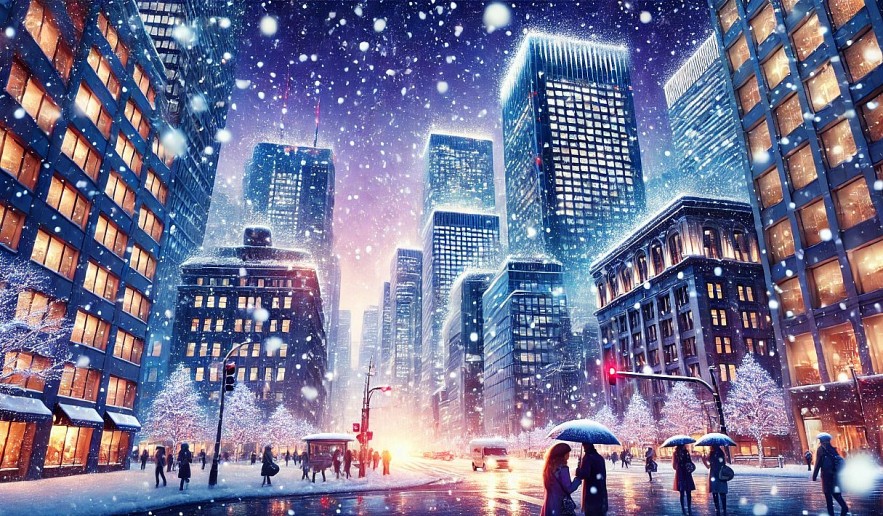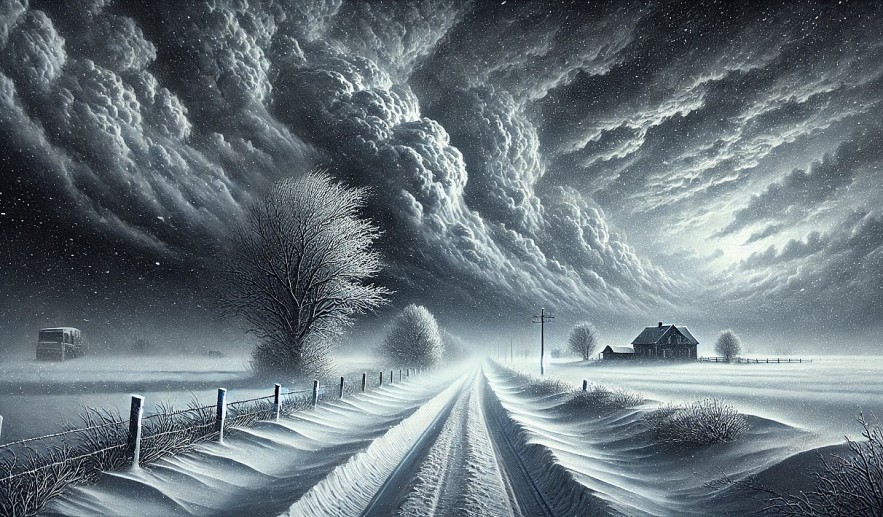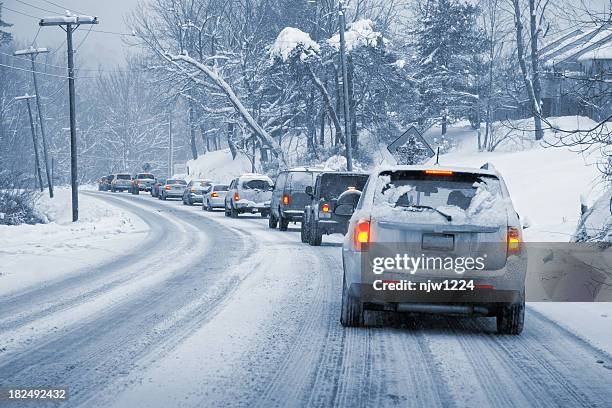U.S. Snow Forecast for Winter 2024 - 2025 (Update)
Winter weather holds immense importance for both the general public and key industries in the United States. Snowfall impacts travel, energy consumption, agriculture, and local economies. Winter weather forecasts are crucial for individuals, businesses, and governments across the United States.
Accurate predictions help in preparing for potential disruptions, ensuring safety, and mitigating economic impacts. As we approach the winter of 2024-2025, understanding the expected snowfall patterns becomes essential.
 |
| Interactive Snowfall Forecast Map |
Key Climate Drivers Influencing Snowfall
La Niña and Its Effects
La Niña winters typically bring cooler and wetter conditions to the northern tier of the U.S., while the southern regions tend to be drier and warmer. These dynamics are set to influence this winter, creating conditions favorable for significant snowfall in certain areas.
Arctic Oscillation (AO) and Polar Vortex
A negative phase of the Arctic Oscillation allows Arctic air to plunge southward, increasing the likelihood of cold air and snowstorms in the Midwest, Northeast, and Mid-Atlantic. If the Polar Vortex destabilizes, it could amplify these conditions, resulting in harsher snow events.
Climate Change Impact
While climate change complicates predictions, it has been observed to increase the variability and intensity of snowfall. Warmer atmospheric conditions can hold more moisture, sometimes leading to heavier precipitation during snow events.
National Snowfall Projections
Northeastern United States
The Northeast is expected to experience above-average snowfall this winter due to an active storm track and favorable conditions for nor'easters. Cities like Boston, New York, and Philadelphia are preparing for potentially significant snowfall, with projections including:
- Boston, MA: 55-65 inches of snow (10-15% above average).
- New York City, NY: 25-35 inches of snow (slightly above average).
- Philadelphia, PA: 20-30 inches of snow, including potential blizzard conditions.
Peak snowfall events are likely in January and February, with nor'easters bringing widespread impacts, including coastal flooding and strong winds.
Great Lakes and Midwest
The Midwest and Great Lakes region are forecasted to experience enhanced lake-effect snow due to colder-than-usual air masses interacting with the warmer Great Lakes water:
- Chicago, IL: 40-50 inches of snow (close to average but concentrated in late January).
- Detroit, MI: 45-55 inches of snow, with strong lake-effect events.
- Buffalo, NY: 70-90 inches of snow, particularly heavy lake-effect storms.
Lake-effect snow events will be frequent, with the strongest occurring in December and early February. These regions should also prepare for isolated snow squalls that reduce visibility.
Pacific Northwest
The Pacific Northwest will likely see one of the snowiest winters in recent memory, driven by persistent storm systems:
- Seattle, WA: 15-25 inches of snow, nearly doubling the typical seasonal average.
- Portland, OR: 5-10 inches of snow, with icy conditions likely.
Higher elevations, including the Cascades, are expected to receive up to 250 inches of snow, which will be beneficial for water reservoirs but challenging for travel and outdoor activities.
Rocky Mountains and Intermountain West
The Rockies will experience abundant snowfall, with ski resorts like Aspen, Vail, and Jackson Hole poised for an exceptional season:
- Denver, CO: 50-60 inches of snow (above average).
- Salt Lake City, UT: 55-65 inches, boosting the state’s ski tourism.
Snowpack in this region is crucial for spring water supply, and forecasts suggest near-record levels in some basins.
Southern United States
The southern U.S. will experience a drier-than-average winter, but isolated snow events could surprise areas unaccustomed to significant accumulation:
- Dallas, TX: Less than 2 inches of snow expected, but a brief winter storm may occur in February.
- Atlanta, GA: Trace amounts of snow, with greater risk for icy roads.
Unusual snowfall could reach parts of the Gulf Coast and Deep South, though these will be fleeting and dependent on strong Arctic outbreaks.
Northern Plains and Upper Midwest
This region is bracing for a brutal winter, with frigid temperatures and frequent heavy snow:
- Minneapolis, MN: 50-65 inches of snow, with extended periods of sub-zero temperatures.
- Fargo, ND: 70-80 inches of snow, making it one of the snowiest winters in recent years.
Blizzard conditions are likely to occur multiple times, with February being the peak month for snowstorms.
Southwestern United States
The Southwest is forecasted to have a relatively dry winter, but higher elevations could see significant snow:
- Flagstaff, AZ: 70-80 inches of snow, focused on January.
- Northern New Mexico: 40-50 inches, especially in mountain ranges.
Notable Snow Events to WatchJanuary 2025 Nor’easter: A strong nor’easter is predicted to impact the Eastern Seaboard, potentially dumping 1-2 feet of snow from Washington, D.C., to Boston. Coastal regions may face storm surges. Lake-Effect Snowstorm (December 2024): Buffalo and Erie are expected to face a massive lake-effect event with accumulations exceeding 3 feet in isolated areas. Blizzard Potential in February 2025: The Midwest could experience a widespread blizzard, disrupting travel across major highways and airports. |
 |
| Dynamic Snowfall Scene in a Cityscape |
Preparedness Tips and Mitigation
To stay safe and minimize disruptions, Americans should take the following steps:
• Monitor Weather Updates: Regularly check reliable sources like NOAA, AccuWeather, and local forecasters for up-to-date information.
• Emergency Kits: Prepare kits with essentials, including water, non-perishable food, flashlights, batteries, and first-aid supplies.
• Winterize Homes and Vehicles: Insulate pipes, maintain heating systems, and equip cars with snow tires and emergency tools.
Travel Caution: Avoid unnecessary travel during storms and monitor road conditions when on the move.
Sector Impacts
Transportation
- Roads: Heavy snowfall and icy conditions will challenge highway systems, particularly in the Northeast and Midwest.
- Airports: Major hubs like Chicago O’Hare, Boston Logan, and Denver International should prepare for significant delays during peak storm periods.
Energy
- Heating Demands: Cold northern winters will drive up heating costs, stressing energy grids and potentially causing localized outages.
- Renewables: Snowpack in the Rockies and Cascades will bolster hydroelectric power generation in the spring.
Agriculture
- Livestock: Farmers in the Northern Plains must prepare for extended periods of extreme cold and heavy snow.
- Water Reserves: Increased snowpack in the Rockies and Pacific Northwest will benefit irrigation systems in the spring.
Top Best Agencies for Snowfall Predictions in the U.S
 |
| U.S. Snow Forecast for This Winter |
-
NOAA (National Oceanic and Atmospheric Administration)
NOAA provides comprehensive seasonal forecasts through its Climate Prediction Center. For Winter 2024-2025, NOAA predicts colder, snowier conditions in the northern U.S. and warmer, drier weather in the South.
- Details: NOAA Winter Outlook
-
AccuWeather
Known for real-time updates and localized forecasts, AccuWeather anticipates significant snow in the Great Lakes and Northeast, with fewer storms in the South.
- Details: AccuWeather Forecast
-
Farmers’ Almanac
Famous for its long-term predictions, it forecasts a "wet whirlwind" winter with rapid-fire storms and notable snowfalls in Texas and the Northeast.
- Details: Farmers' Almanac
-
The Weather Channel
Combines NOAA data with proprietary models to offer accessible forecasts, focusing on live updates for snowstorm tracking.
-
National Weather Service (NWS)
Provides localized snow warnings and real-time weather alerts via high-resolution radar and snowfall maps.
- Explore: Weather.gov
-
Regional Climate Centers (RCCs)
Specialized in localized snowfall trends, RCCs focus on specific regions like the Northeast, Midwest, and Rockies for detailed analysis.
Conclusion
Winter 2024-2025 promises to be a season of contrasts, with heavy snowfall in the northern U.S. and drier conditions in the South. As La Niña influences dominate, regions like the Northeast, Great Lakes, and Pacific Northwest should prepare for significant snow events, while occasional surprises may impact typically snow-scarce areas in the South. Staying informed and prepared will be essential to weathering the season safely.
























